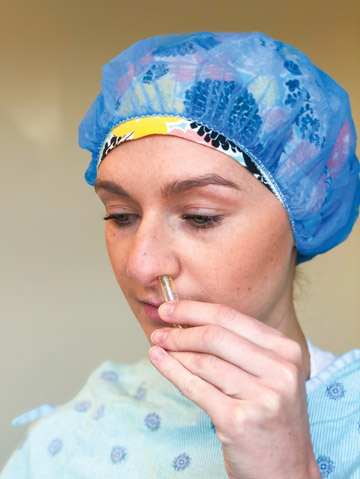The challenge with mupirocin is that it requires screening at least a week in advance, and then the patient has to strictly follow the regimen at home for five days, which presents the risk of noncompliance or incomplete compliance. There's also
growing concern about mupirocin resistance, resulting from its wide use over a long period of time. Mupirocin's colonization eradication rate typically is extremely high — 93% to 95% ?— but if there's high-level mupirocin resistance,
you often get no reduction in colonization. With intermediate or low-level resistance, there may be a transient reduction in the number of organisms, but a quick rebound takes place at the end of the first week. In terms of surgical prophylaxis,
we still don't know if a transient reduction is good enough.
I don't believe there's been a major shift away from mupirocin yet, but there's a trend toward trying to find something better and easier to use. In the next year or two, a number of studies should be published that help clarify whether we're
seeing increased mupirocin resistance. Meanwhile, there's renewed interest in evaluating newer nasal agents that can serve as alternative methods of nasal decolonization. The action centers around PI, alcohol-based swabs and an interesting
technique being used in Canada called photodynamic therapy.
- Povidone-iodine (PI). At least three peer-reviewed articles have investigated using PI for nasal decolonization. One advantage of PI is that no resistance to S. aureus has yet been reported. Another is the way the PI regimen
is designed. You don't need to worry about screening days in advance. You simply administer PI in the pre-op area before surgery — two applications in each nostril twice before the patient goes into the OR. Studies have indicated
that PI reduces SSIs, and the literature around it is growing. It doesn't have the same level of evidence yet as mupirocin, but it's a much simpler regimen that's especially attractive to outpatient surgery centers.
Keep in mind that all PI isn't created equal, however. At least three companies market a PI product indicated for intranasal use. These intranasal versions of PI contain chemicals that help it attach better to the nasal mucosa, which is where
the mechanism of action is. There's a cost issue here, unfortunately: These specialized PI preparations are multiple times more expensive than generic over-the-counter PI swabs. However, one study shows that, in terms of eradication rates,
the intranasal preparations are better than the less expensive preparations. If someone asks me, I tell them to stick with the intranasal PI preparation until someone proves over-the-counter versions are more effective. Sure, it's more expensive
than generic PI, but it's not nearly as expensive as an SSI.
- Alcohol-based antiseptic. At least one peer-reviewed study confirms that alcohol-based nasal decolonization swabs can be effective. The mitigating issue with alcohol is that it has a very short duration of action. It must
be applied multiple times a day, which leads to the compliance issues inherent to mupirocin. The key takeaway here is that alcohol treatments must be applied frequently to keep colony counts down.
- Photodynamic therapy. This emerging regimen is fascinating. Most peer-reviewed studies involving this technology are coming from Canada, because the FDA hasn't approved it as a device in the U.S. Photodynamic therapy carries
no compliance concerns; it's applied just before surgery. You place a material in the nose, generally a methylene blue kind of preparation. Then you deliver a certain wavelength of photodynamic therapy that combines with the methylene
blue to eradicate bacteria very safely. Some peer-reviewed studies show it does reduce SSI risk. While we can't use this therapy in the U.S. yet, it's worth keeping an eye on it.
These four regimens are the most viable nasal decolonization methods that have been shown to be effective. But again, none of them has the same level of evidence or the same number of publications that mupirocin has.
The nasal decolonization picture will likely become clearer in the next couple of years.
There's a fifth possibility — retapamulin, which is currently used for skin and soft tissue infections. It has lost favor, however, mostly due to bleeding and irritation associated with its intranasal use, and there's still very limited information
about its use for nasal colonization. It really does seem to work, though, so I think it's still a potential option down the road.
.svg?sfvrsn=be606e78_3)

.svg?sfvrsn=56b2f850_5)